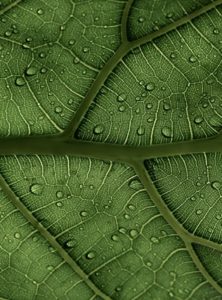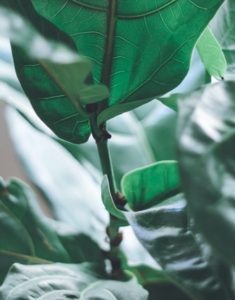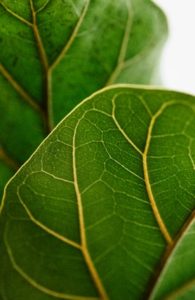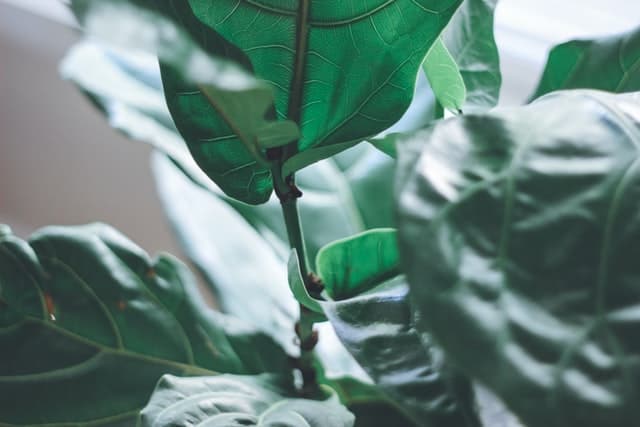Some links in the post are affiliate links and I get a commission from purchases made through some links found in the post.
The fiddle-leaf fig – also known as Ficus lyrate – comes from the fig and mulberry family.
It was first found in western Africa and often grows in tropical rainforest, where it can reach heights of up to 50’.
The plant is extremely popular with interior decorators, in fact you can find it in many stores made in polyester because it is so popular and well-used.
Anyone who has one of these plants will tell you that they can be temperamental.
They do not like being moved from one place to another, particularly if they are happy where they are placed.
Fiddle-leaf figs need good drainage and enough sunlight, although it must not be direct sunlight.
If these conditions are met your fiddle-leaf fig will reward you with bright green glossy leaves.
Why is it Called a Fiddle Leaf Fig?
The name comes from the resemblance that the large leaves have to the shape of a violin. The leaves can become huge and easily grow up to 12 inches across.
Your fiddle-fig, once it has decided that it is happy where it is placed, will easily grow up to 6’ high and give a stunning look to any room you place it in.
Why Does Your Fiddle Leaf Fig Have Multiple Stems?
 As with any hedges, vines, or bushes, you will see that several stems appear to be growing from one place and your fiddle-leaf fig has multiple stems.
As with any hedges, vines, or bushes, you will see that several stems appear to be growing from one place and your fiddle-leaf fig has multiple stems.
Whenever we prune or trim back the fiddle-leaf it will grow extra stems in that place. This is nature’s way of ensuring that the plant continues to grow and also gets enough food to keep it growing well.
If you have recently bought a fiddle-leaf fig, you may also see that there is more than one stem.
This is because it has either been trimmed and pruned back, or more than one stem has been placed in the pot, possibly to ensure that there is a better chance of the plant surviving – and you not returning it because it has died!
Another reason why you may see more than one stem is that the plant has been encouraged to grow into a bush rather than a tree.
Again, if you have recently acquired the plant, give it time to settle down before changing anything, because any change to the fiddle-leaf is radical.
Whatever the reason, if you have recently brought your fiddle-leaf home, it is best to leave it alone while it settles down in new surroundings before removing any stems.
Should you Split a Fiddle Leaf Fig Which Has Multiple Stems?
Most fiddle-leaf figs start out as bushes. This is because they look more attractive when you see them in the garden centre – all shiny and bushy, rather than with just one thin stem as new trees look.
There are two reasons why you may want to split your fiddle-leaf.
- To turn it into a tree
- To separate it into extra plants
Possibly another reason to split your fiddle-leaf is that one stem seems to be dying and you want to remove it.
Because sometimes several plants are placed in one pot to sell better, it is possible that one may not survive and start to die.
You can investigate the stems to see if they are in fact more than one plant by gently teasing the soil away around the stems.
You will be able to see quickly if the multiple stems are from one plant or from several individual plants.
If you decide to split the stems from one plant and (hopefully) get another one or two there are some things to keep in mind.
A Quick Look at Fiddle Leaf Roots
You may think that the large root which reaches to the base of the pot is what keeps the plant alive. This is not so. This is not the root that absorbs nutrients for the plant.
The large root simply works as an anchor to hold the plant in place because it can grow so tall. The little roots that spread all around the stem are what keep the plant alive.
The tiny roots absorb water and nutrients to keep the fiddle-leaf healthy. If you do not handle these roots with care, your fiddle-leaf will go into shock and may even die on you.
If you plan on separating the plant stems you should be prepared to do this over about 6 weeks (yes, they are that much against change!)
First you should prepare the new pots. Also make sure that your equipment is clean, and the knives are sharp. Use a new potting mix instead of any used mix.
How to Separate the Fiddle Leaf Fig Stems
Using a clean spade, you should dig down gradually between the stems.
If you meet resistance you should use pruning shears to gently cut through. This can take you several days as it should be done slowly and very gently.
Try to keep the plants upright – this may become a two-man job!
Gently separate the plants and lift one out. Place in its new pot, keeping upright as you fill around the plant with fresh soil.
Give the new plant a good water and make sure that it runs all the way through and out of the bottom. This will tell you that there is adequate drainage which the fiddle-leaf needs.
And now – leave it alone! Don’t be tempted to mess with your new plant, or even the old one. Remember that they have been shocked and need time to recover.
You will not see any new growth for about four months on either plant after you have split the stems. This is because the plants are in the recovery process and conserving their energy.
Remembering that if your fiddle-leaf fig has multiple stems there may be more than one fiddle leaf fig plant in your pot.
How to Train Your Multiple Fiddle Leaf Stems Into a Tree Shape?
 This is a question you may well ask, particularly if fiddle-leaf figs are new to you. The answer is yes, you can.
This is a question you may well ask, particularly if fiddle-leaf figs are new to you. The answer is yes, you can.
This is one plant that can be changed from a bush to a tree. It must be done with care but because the plant is so versatile you can change the appearance quite easily.
You need to be patient if you plan to grow a fiddle-leaf tree as they take longer to grow than bushes.
Also, when you see a selection of fiddle-leaf figs in a garden centre you may be better off buying the bushy type rather than a tree.
At least one or two of the stems will survive the relocation, while a tree may not.
Turning Your Fiddle Leaf Fig From a Bush Into a Tree
There are three components that we need to look at, namely the height, trunk, and the branches.
Your fiddle-leaf will grow providing the conditions are right. They need light, water, and soil to be healthy. If your plant is not growing, start to investigate by looking at these areas.
While over time the lower leaves will drop off themselves, you may not want to wait that long to have a tree. Removing the bottom leaves will not mean they grow back – they don’t.
Be selective about which leaves you remove as they support the trunk and strengthen it.
Start off with the bottom leaves and take off a few at a time instead of all the way up to the hight you require. You should do this over several weeks, nice and slowly.
Once you have decided on the height of your new tree then you will need to prune or pinch out the tip.
This will encourage the plant to put out extra branches. Because you have pruned the tip, the plant sends out other shoots. Soon you will have new shoots coming out at the sides.
With careful trimming at the tip you will be able to shape your new tree.
How to Encourage Multiple Stems for Your Fiddle Leaf Fig
Just like any other plant that grows in the wild, it will naturally sprout extra stems. This is one way for plants to propagate themselves.
Another way for a plant to grow extra sprouts or stems is when we prune it. Next time you chop down a hedge have a look at all the new shoots that come up the following year.
Your fiddle-leaf fig is no different to this. Pruning and trimming back will encourage new shoots which become stems, giving you a bushier plant.
To encourage multiple stems, you should also consider the size of the pot. The more room the roots have, the more they will grow and the more you will see extra stems.
How to Encourage Branching of Your Fiddle Leaf Fig
Branching is similar to growing extra stems in that extra growth will naturally take place in the area where stems or branches are removed.
Pruning
Pruning is the easiest way to get your fiddle leaf to branch more. Select the height you want to new growth to start and cut off the stem.
What has happened is that the dormant buds below the cut line have now been activated. Auxin – the growth hormone – cannot travel up the stem and redirects it to the buds that are closest to the cut.
If you want more than one new bud then make sure to prune above a group of leaves that are close together. This will encourage several buds.
You can also form more buds from the nodes – these are small rings which you will find around the stem.
You should see your new buds starting to appear within two weeks although this can take longer depending on how happy your fiddle-leaf is in his home.
A note here:
You should prune slightly higher than where you would like the branches to be because you will be removing a piece of the stem, so if you want a plant that is 4 feet in height, you should prune at two feet to allow new branches to grow to the desired height.
Notching
Notching is more finicky than pruning and can be less successful if you are not careful.
You need to make a diagonal cut around about 30% of the stem. This should be made just above a node or leaf.
In effect, notching is a method of making small cuts on the stem to encourage new growth. You must take care than you do not cut too deep or you will chop the top of the plant off!
Pinching
This is like pruning although instead of using secateurs to remove pieces, you simply pinch off the top bud or tip on the plant.
This is an easy method if the plant has reached the height you want. All you need to do is pinch off the top of the plant and it will stop growing upwards and start to spread out.
For pinching you can use your thumb and finger to snip off the top. Make sure you wash your hands before and after.
Final Thoughts: Why Does Your Fiddle Leaf Fig Have Multiple Stems?
 For your fiddle-leaf fig to be at its very best you should make sure that any tools you use to prune and notch are sharp and clean so that you can make your cut quickly and cleanly without damaging the stem.
For your fiddle-leaf fig to be at its very best you should make sure that any tools you use to prune and notch are sharp and clean so that you can make your cut quickly and cleanly without damaging the stem.
By making your cuts about ½” away from other leaves you will give the plant the best opportunity to heal with no infection to other leaves.
While this plant may seem to need a lot of attention, once you have found ‘its special place’ you will have a plant that is beautiful and striking, and gives you pleasure for many years.
Written by: Valerie Holyoak
Before you go, here are some more related articles I encourage you to read below to help solve more of your gardening issues:
How to Get Rid of Spider Mites on a Fiddle Leaf Fig

